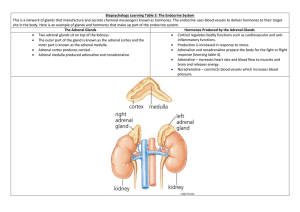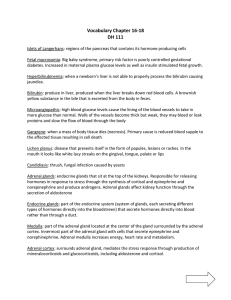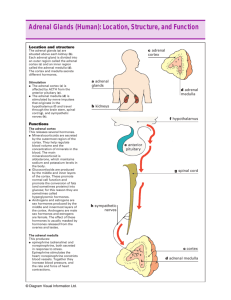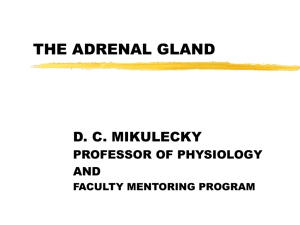Adrenal Gland
advertisement
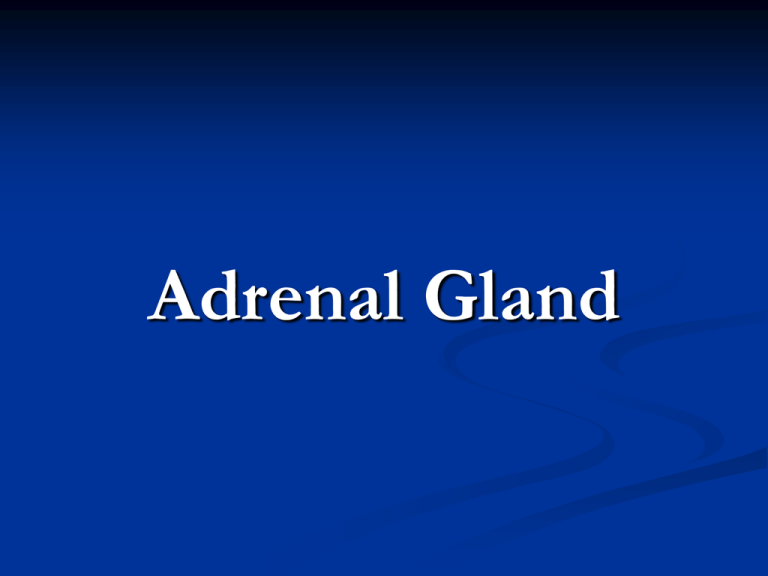
Adrenal Gland LOCATION Adrenal Gland The adrenal glands (also known as suprarenal glands) are the triangle-shaped and orange-colored endocrine glands and measure about one-half inch in height and 3 inches in length located on the top of both kidneys at the level of the 12th thoracic vertebra . Structure of The Adrenal Glands Each adrenal gland consists of : Adrenal medulla . Adrenal cortex . The Adrenal Medulla adrenal medulla is the inner part of the adrenal gland and surrounded by the adrenal cortex and helps a person in coping with physical and emotional stress. Adrenal medulla hormones The adrenal medulla secretes the following hormones : epinephrine (also called adrenaline) : Epinephrine is a hormone produced in the body by the adrenal glands. It is released at times of acute stress to enhance our capability . this hormone increases the heart rate and force of heart contractions, facilitates blood flow to the muscles and brain, causes relaxation of smooth muscles, helps with conversion of glycogen to glucose in the liver. ` norepinephrine (also called noradrenaline): this hormone has little effect on smooth muscle, metabolic processes, and cardiac output, but has strong vasoconstriction effects, thus increasing blood pressure. The Adrenal Cortex The adrenal cortex is the outer portion of the adrenal gland consists of three different regions, with each region producing a different group or type of hormones that carry out specific functions throughout your body. Adrenal Cortex hormones The adrenal cortex produces three major groups of steroid hormones collectively called ( corticosteroids): 1) Mineralocorticoids (outermost ) Glucocorticoids (middle ) sex hormones (innermost ) 2) 3) Adrenal Cortex MINERALOCORTICOIDS Mineralocorticoids are secreted by the outermost region of the adrenal cortex. The principal mineralocorticoid is aldosterone, which is the major hormone controlling the sodium and potassium levels, Aldosterone responsible for the reabsorption of sodium and stimulates the excretion of potassiumand thus fluid balance, within your bloodstream. GLUCOCORTICOIDS Glucocorticoids are secreted by the middle region of the adrenal cortex.which include cortisone and cortisol.Cortisol controls or greatly influences the metabolism of fats, proteins to maintain blood glucose within a narrow optimal range and keep it there even under stressful conditions. SEX HORMONES sex hormones are secreted by the innermost region of the adrenal cortex. Androgens (Male hormones) Estrogens (female hormones) Cushing's Syndrome Cushing's syndrome is the result when your body makes too much cortisol and commonly affects adults aged 20 to 50. An estimated 10 to 15 of every million people are affected each year. Causes of Cushing's syndrome The most common cause is taking cortisone-like medicines orally (by mouth) every day for weeks to months. Prednisone for asthma, rheumatoid arthritis is the most common medicine that's taken this way. Cushing's disease is common cause of Cushing syndrome because excessive production of the hormone ACTH by the pituitary gland. ACTH stimulates the adrenal glands to produce cortisol. symptoms of Cushing's syndrome The following are the most common symptoms: increased fat around neck. fragile and thin skin. stretch marks on abdomen, thighs, arms, and breasts. bone and muscle weakness. severe fatigue. irritability and anxiety. irregular or stopped menstrual cycles in women Treatment Treatment depends upon the cause of the disorder: In Cushing syndrome caused by drug therapy , the drug dose must be slowly decreased under medical supervision. In Cushing's disease caused by a pituitary tumor, surgery to remove the tumor is recommended. Cushing's syndrome diagnosed x-rays to locate any tumors. 24-hour urinary test to measure for corticosteroid hormones. Cortisol levels are higher in the morning than at night. Reference range of cortisol: In morning: 250 - 850 nmol/L At night: 110 - 390 nmol/L Reference range of ACTH: 7 – 40 m IU/L Addison's Disease Occurs when the adrenal glands do not produce enough of the hormone cortisol and in some cases aldosterone. can start at any age .The disease is also called adrenal insufficiency. Causes of Addison's Disease Disorder of the adrenal glands. Tuberculosis. Adrenal cancer. surgical removal of the adrenal glands Autoimmune disorders. Irritability and depression Symptoms of Addison's Disease weight loss. loss of appetite. muscle weakness. nausea . vomiting . Diarrhea. Treatment Cortisol is replaced orally with hydrocortisone tablets taken once or twice a day. Aldosterone is also replaced with oral doses of a fludrocortisone. Diagnosis Determine the levels of cortisol. Reference range of Aldosterone : In blood : 4 – 9 microgram/100mL In urine : 2 – 18 microgram/24 hours
